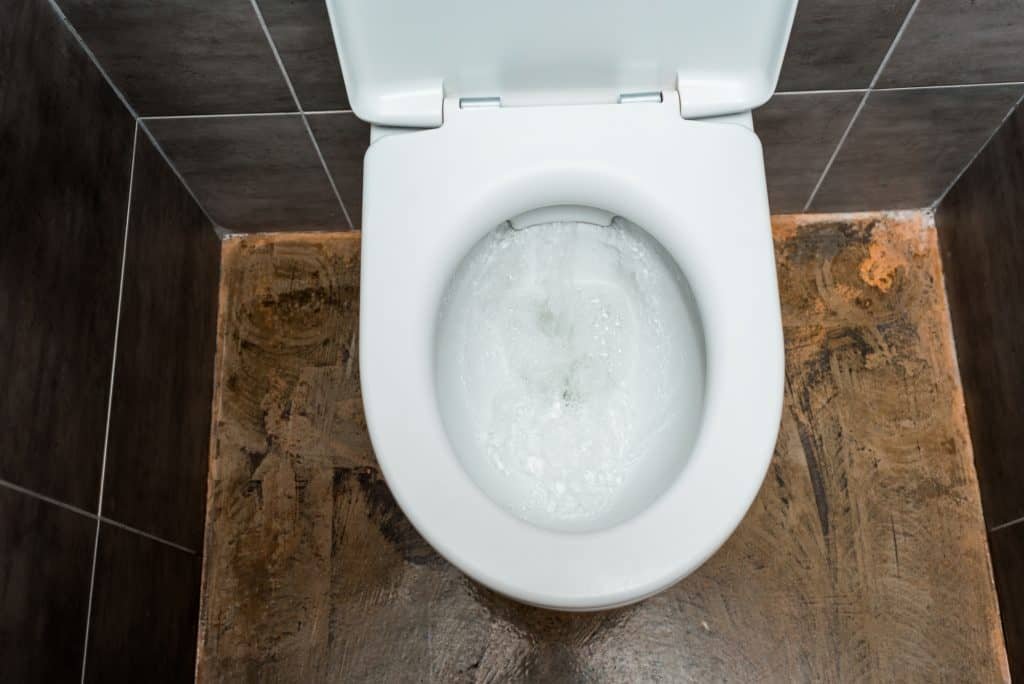Toilets rely on differences in air pressure and gravity to successfully clear waste products from the toilet bowl. The toilet bowl holds water that maintains an air pressure equilibrium between it and the rest of the toilet’s drainage system.
However, some issues can compromise your toilet’s functioning resulting in sewer gases leaking into your bathroom through your toilet bowl (source: Healthline).
Foam in your toilet could result from drainage issues like a drain pipe or vent clog, which prevents gases in your drainage system from escaping using conventional routes, causing the gases to seep out through your toilet bowl. Excessive use of detergent can also cause foam in your toilet.
The following is a breakdown of potential reasons your toilet has soap suds or toilet foam after flushing in the toilet bowl.
What Causes Soap Suds in My Toilet Bowl?
Soap suds in your toilet bowl may come from incorrect plumbing components, overuse of detergents and cleaning solutions, or blockage somewhere in the drain line. They are often temporary, but persistent suds may indicate an underlying plumbing issue.
The following explains how said situations will result in the production of soap suds in
Bad Plumbing
If your drainage pipe runs straight down from your toilet, it might allow water mixed with cleaning products to accelerate and splash down at the bottom with a force that generates soap suds that might accumulate over time. Consequently, the suds will appear in your toilet bowl.
Therefore, your plumbing should have enough bends to decrease fluid speed to prevent the production of soap suds while also avoiding clogs.
Overuse of Cleaning Products
Using excess laundry detergents generates excess lather, accumulating in your drainage system. The accumulated lather might make its way up the drain and appear in your toilet bowl.
The situation can be particularly extreme in a multi-story building with multiple households making the same mistake.
Clogs in the Drainpipe
When there is a clog in the drainpipe, water containing cleaning products, maybe from bathtubs and washing machines, will build up at the source of the clog.
As a result, the soapy water will develop suds that occasionally appear on the toilet bowl. Frequent clogs warrant corrective action before the situation deteriorates.
To help clear a clogged drain and prevent the appearance of soap suds, consider buying the Dometic Bowl Cleaner/Tank Treatment (available on Amazon.com). The product has rapidly dissolving packs that help break down human waste and toilet paper, thereby unclogging your pipes.

Why Does My Toilet Foam After Flushing?
Toilets can foam after flushing as a result of blockage in the drain pipe or vent stack. It could also mean your septic tank is full. Consequently, the gases in your drainage system find an outlet through your toilet bowl, hence the foaming.
The following is a breakdown of the circumstances under which your toilet can foam after flushing:
- Clog in the drainpipe. Flushing creates a pressure difference allowing water to flow from the tank with the help of gravity and force its way through the trapway and into the drainpipe (source: Kohler).
A clogged drainpipe means the air within it has no escape route when you flush. Therefore, the air makes its way back up the pipe, leaving through the toilet bowl, causing foaming. - Blocked vent stack. The same principle applies when there is a blockage in the vent stack since it allows gases produced within your drainage system to escape to the top of your home.
A blocked vent stack prevents sewer gas from escaping, thus forcing the pockets of gas to escape via your toilet bowl resulting in your toilet foaming when you flush. - Filled up septic tank. Gases within the drainpipe often escape into the septic tank when you flush. However, if the septic tank is full, the gases have nowhere else to go but back up through your toilet bowl.
Therefore, it is advisable to empty your septic tank to deal with your toilet foaming issues.
If the issue is a blocked vent stack, you can climb to the roof of your house, open the vent cap, and try to remove whatever is causing the blockage, like dry leaves. If that fails, pour water down the vent to unclog the vent.
However, if the clog is within the drainpipe, you can purchase this RIDGID Model K-3 Toilet Auger (available on Amazon.com). The toilet auger has a flexible and durable 3-foot-long snake that can make its way around the twists in the toilet’s design and unclog the drain pipe.

What Causes My Toilet to Foam When I Pee?
If your toilet foams when you pee, it is more than likely related to the stream of urine, as opposed to the toilet itself. A full bladder or concentrated urine can cause foam in your toilet, or you might have a medical condition that is leading to foamy urine.
Therefore, there are three main reasons your toilet would foam when you pee.
- Full bladder. Urine can foam up, especially when your bladder is full occasionally. The urine leaves your body at a high pressure or a high speed of urination, disrupting the water inside the toilet bowl.
However, in such instances, the foam clears very quickly. Therefore you should observe how long the foam lasts. - Concentrated urine. When your water intake is low, you become dehydrated, meaning your organs utilize most of the water in your body.
Consequently, when your urine becomes concentrated with waste material cleaned from your bloodstream, it might produce foam in the toilet bowl. - Diseased kidney. The kidneys remove excess water and waste material from your blood, which is passed out in the urine.
However, if your kidneys are damaged, they are likely to allow material needed by your body, like protein, to mix into your urine, resulting in your toilet foaming when you pee (source: Healthline). Diseases like lupus or diabetes may cause kidney damage.
To confirm whether the issue is medical-related, you can try the One Step UTI Testing Kit (available on Amazon.com). It is fast, reliable, and accurate, testing for proteins in urine. If the result is positive, you should see a doctor for more guidance.
Various reasons may cause suds or foam in your toilet. Use this article as a guide to eliminate where the issue lies.

